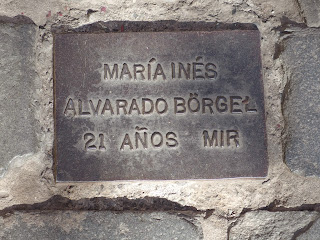Our last two days in Santiago we visited some sights we'd missed and re-visited the always-interesting Plaza des Armas. We took a taxi to the
Cerro San Cristobal, intending to take the funicular to the top of the tallest hill in Santiago. The funicular was down for maintenance, but buses were running up and down. The hill is best known for the statue of the Virgin Mary, atop the hill and visible for some distance. The statue was made in France and was intended to be in place for the 50th anniversary of the proclamation of the Immaculate Conception. The statue wasn't ready, and was finally emplaced 3 years later. It is still the site of religious pilgrimages, and was visited by Pope John Paul II during his visit to Chile in the 1970's.
 |
| The Funicular, Which We Couldn't Take |
 |
| Our Lady of the Transmission? |
 |
| Looking Down on the City, with the Andes Through the Smog |
 |
| An Interesting Building in the Bellevista Neighborhood, at the Foot of the Hill |
We also paid a somber visit to one of the few reminders of the atrocities of the Pinochet regime. Most of the buildings associated with Pinochet were destroyed. The survivors of the 98 victims tortured and killed at 38 Londres Street between 1973 and 1975 lobbied to keep the innocuous-looking building as a memorial to those they had lost. The building is now a museum, but with very limited hours. We did not go inside, but were very touched by the sight of the bricks in the pavement in front of Number 38, giving the names and ages of those who were killed.
 |
| 38 Londres Street |
We re-visited the San Francisco Church, the oldest building in Santiago, and visited the Colonial Museum which is situated in the former cloisters of the church. The museum contains a large number of religious artifacts, but also a room devoted to Gabriela Mistral, Pablo Neruda's third wife and, like him, a Nobelist in literature.
 |
| Mistral's Nobel Proclamation |
Appropriate to Saint Francis, the museum courtyard contained at least a few examples of animal life. A rooster strutted around and crowed, and what I took to be sculptures turned out to be live turtles at the fountain.
On our prevous visit to the San Francisco Church, I'd missed the side altar devoted to St. Francis with a dog, and the photos of dogs attached in gratitude for favors granted. As we approached, a woman came in carrying a small, apparently quite old dog and began to pray at the altar. We hope her prayers were answered!
We visited the St. Augustine church to see the Christ figure with the "slipping crown."During an earthquake, the crown of thorns slipped from the head to the neck of the statue. When it was replaced on the head, the face of the figure bled, so it was placed back around the neck and there it remains. The statue reclines on a wagon, and is pulled
in procession on special days.
 |
| The Crown Around the Neck |
 |
| The Statue on the Wagon |
|
Of the many side alters in the church, the most popular was one devoted to St. Rita,
Abogado de Impossibles. We assume this meant an advocate and not an attorney? for impossible causes. Anyway, the altar was busy and full of floral offerings.
 |
| St. Rita's Altar |
We stopped by the
Basilica de la Merced and the adjacent museum, housed in the cloisters of the
Merced (Mercy) order. The basilica was built in the late 1700's. Plaques are attached to the altars of the various saints, in gratitude for favors granted. The two most popular were the statues of St. Jude and St. Expedito.
 |
| The Basilica |
 |
| Carved Pulpit in the Basilica |
 |
| St. Expedito. He Must Have Granted Many Favors. |
The adjacent museum had a beautiful location in the cloisters of the former monestary. The exhibits ranged from Easter Island artifacts to rather curious (to us) representations of the infant Jesus.
 |
| Easter Island Stone Carvings |
 |
| A Few of the Many Infant Jesus' Under Glass |
 |
| Carved Figure from Ecuador. Wearing Tighty Whities? |
 |
| The Gardens of the Museum |
There are lots of steet musicians in Santiago, classical, to Chilean, to rock.
 |
| Musicians on the Alameda | | | | | | | | | | | | | | | | | | | | | |
The Plaza de Armas was our favorite spot in Santiago, always busy and usually entertaining. The central post office is located on the Plaza in a beautiful
Bellas Artes building. Business is conducted in less beautiful surroundings. You take a number, find a seat, and wait to be called up to buy stamps or whatever (it reminded us of renewing our drivers' licenses at the Hennepin County government center).
 |
| The Main Post Office |
 |
| The Great Hall of the Post Office |
 |
| The Not-so-Great Wait. Over 30 Minutes to Buy Stamps. |
|
There was always something going on at the Plaza. You could see a living statue -
Listen to an orator-
Have your photo taken on horseback-
Or take a photo of the mounted police in front of the mounted statue of Pedro de Valdivia-
Or have your photo taken with some other horses' posteriors (sorry Nick)






























No comments:
Post a Comment